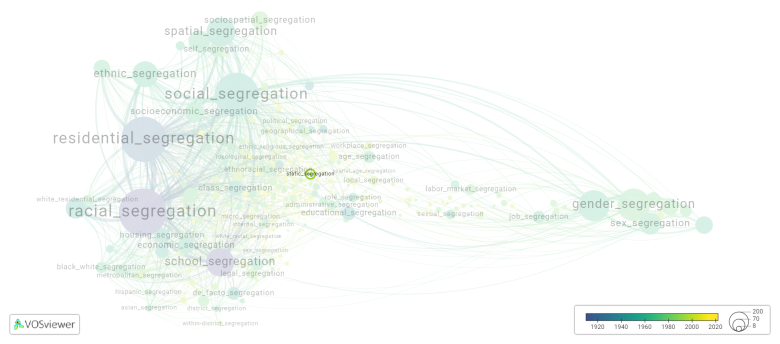Static segregation: Difference between revisions
(Creating page) |
(Creating page) |
||
| (5 intermediate revisions by the same user not shown) | |||
| Line 6: | Line 6: | ||
Static segregation refers to the separation of individuals or groups based on certain characteristics, such as race, ethnicity, or socioeconomic status, that is maintained through fixed or unchanging structures or systems. This can include physical separation in housing, education, or employment, as well as social or cultural barriers that prevent interaction between different groups. Static segregation is often a result of historical or systemic inequalities and can perpetuate disparities and marginalization. | Static segregation refers to the separation of individuals or groups based on certain characteristics, such as race, ethnicity, or socioeconomic status, that is maintained through fixed or unchanging structures or systems. This can include physical separation in housing, education, or employment, as well as social or cultural barriers that prevent interaction between different groups. Static segregation is often a result of historical or systemic inequalities and can perpetuate disparities and marginalization. | ||
==See also== | ==See also== | ||
==Related segregation forms== | |||
Static segregation is frequently discussed in the literature with the following segregation forms: | |||
[[social segregation]], [[territorial segregation]] | |||
[[File:static_segregation.png|780x780px]] | |||
This visualization is based on the study [[Segregation_Wiki:About| The Multidisciplinary Landscape of Segregation Research]]. | |||
For the complete network of interrelated segregation forms, please refer to: | |||
* [https://tinyurl.com/2235lkhw First year of publication] | |||
* [https://tinyurl.com/2d8wg5n3 Louvain clusters] | |||
* [https://tinyurl.com/223udk5r Betweenness centrality] | |||
* [https://tinyurl.com/244d8unz Disciplines in which segregation forms first emerged (Scopus database).] | |||
==References== | ==References== | ||
==Notes== | ==Notes== | ||
<references /> | <references /> | ||
{{NoteAI}} | {{NoteAI}} | ||
==Static | ==Static segregation appears in the following literature== | ||
Reibel M. (2003). Measures of geographically uneven subpopulation group change and local group transitions: Examples from Los Angeles. ''Geographical Analysis'', ''35''(3), 257-271. Ohio State University.https://doi.org/10.1111/j.1538-4632.2003.tb01113.x | Reibel M. (2003). Measures of geographically uneven subpopulation group change and local group transitions: Examples from Los Angeles. ''Geographical Analysis'', ''35''(3), 257-271. Ohio State University.https://doi.org/10.1111/j.1538-4632.2003.tb01113.x | ||
Netto V.M., Pinheiro M.S., Paschoalino R. (2015). Segregated Networks in the City. ''International Journal of Urban and Regional Research'', ''39''(6), 1084-1102. Blackwell Publishing Ltd.https://doi.org/10.1111/1468-2427.12346 | Netto V.M., Pinheiro M.S., Paschoalino R. (2015). Segregated Networks in the City. ''International Journal of Urban and Regional Research'', ''39''(6), 1084-1102. Blackwell Publishing Ltd.https://doi.org/10.1111/1468-2427.12346 | ||
Latest revision as of 07:17, 16 October 2024
Date and country of first publication[1][edit | edit source]
2003
United States
Definition[edit | edit source]
Static segregation refers to the separation of individuals or groups based on certain characteristics, such as race, ethnicity, or socioeconomic status, that is maintained through fixed or unchanging structures or systems. This can include physical separation in housing, education, or employment, as well as social or cultural barriers that prevent interaction between different groups. Static segregation is often a result of historical or systemic inequalities and can perpetuate disparities and marginalization.
See also[edit | edit source]
Related segregation forms[edit | edit source]
Static segregation is frequently discussed in the literature with the following segregation forms:
social segregation, territorial segregation

This visualization is based on the study The Multidisciplinary Landscape of Segregation Research.
For the complete network of interrelated segregation forms, please refer to:
References[edit | edit source]
Notes[edit | edit source]
- ↑ Date and country of first publication as informed by the Scopus database (December 2023).
At its current state, this definition has been generated by a Large Language Model (LLM) so far without review by an independent researcher or a member of the curating team of segregation experts that keep the Segregation Wiki online. While we strive for accuracy, we cannot guarantee its reliability, completeness and timeliness. Please use this content with caution and verify information as needed. Also, feel free to improve on the definition as you see fit, including the use of references and other informational resources. We value your input in enhancing the quality and accuracy of the definitions of segregation forms collectively offered in the Segregation Wiki ©.
Static segregation appears in the following literature[edit | edit source]
Reibel M. (2003). Measures of geographically uneven subpopulation group change and local group transitions: Examples from Los Angeles. Geographical Analysis, 35(3), 257-271. Ohio State University.https://doi.org/10.1111/j.1538-4632.2003.tb01113.x
Netto V.M., Pinheiro M.S., Paschoalino R. (2015). Segregated Networks in the City. International Journal of Urban and Regional Research, 39(6), 1084-1102. Blackwell Publishing Ltd.https://doi.org/10.1111/1468-2427.12346
